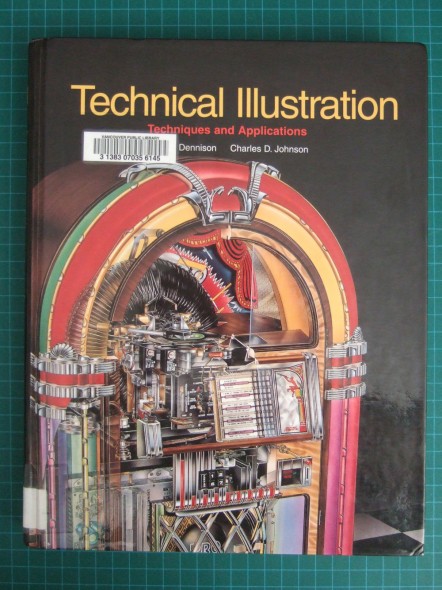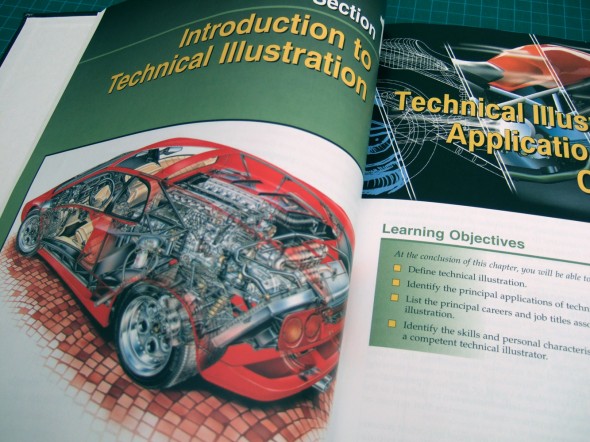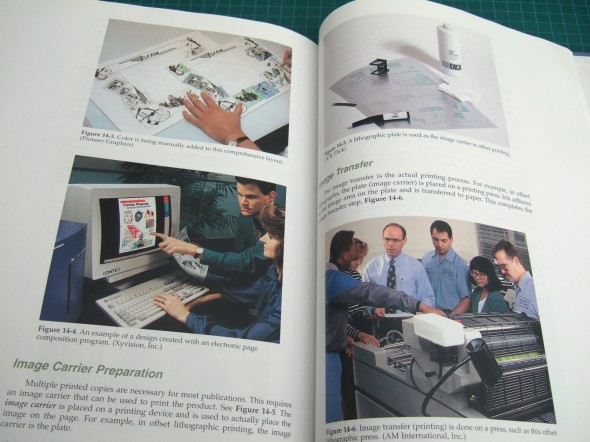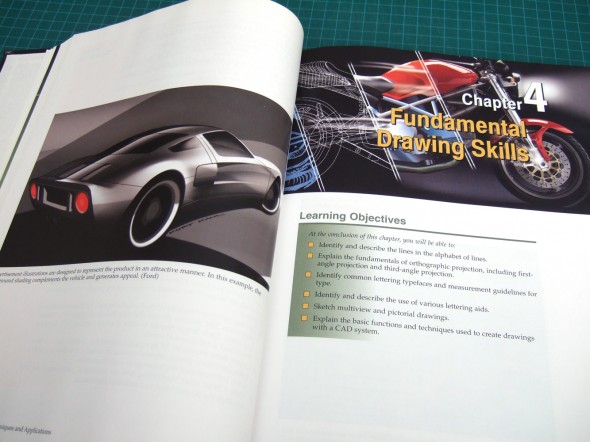Marc Gellen was looking for recommendations for books on technical illustration on Twitter, but ended up providing me with the recommendations. Fortunately, all three books he suggested were available from my local library. I thought I’d give them a brief review here for the benefit of anyone whose public (or private) library might be lacking on the subject.
The first book, Technical Illustration – Techniques and Applications by John A. Dennison & Charles D. Johnson, is a comprehensive course on technical illustration. It is written in a textbook format complete with chapter review questions, drawing problems, and a thorough glossary. It’s well illuminated with photos & diagrams and features a few samples of the airbrush artwork of master technical illustrator David Kimble. Published in 2003 it is the most recent book Marc suggested, but already beginning to show its age.
Here is a brief table of contents:
- Introduction to Technical Illustration
- Technical Illustration Applications and Careers
- Illustration Tools and Techniques
- Composition and Design in Illustration
- Fundamental Drawing Skills
- Pictorial Generation
- Axonometric Drawing Techniques
- Oblique Drawing Techniques
- Perspective Drawing Techniques
- Computer Generated 3D Pictorials and Models
- Illustration Enhancement
- Manual Shading and Rendering Techniques
- Computer Shading and Rendering Techniques
- Color Applications in Illustration
- Airbrush Techniques
- Illustration Applications and Production
- Technical Manuals
- Publication Design and Production
This book is a good introduction to the fundamentals, with an emphasis on traditional drafting tools and techniques. It explores a wide gamut of visual communication from schematic drawings to glossy promotional images. For a beginner it would provide a solid foundation in drawing systems, lighting & shading, color theory, and design & composition. Simple media and techniques to experiment with and build towards more complex drawings.
While the book does touch on computer graphics, it leans more towards CAD than software used to create ‘finished art’. Illustrator and Photoshop aren’t mentioned by name, instead ‘paint programs’ are vaguely alluded to but not explained. More pages are devoted to airbrush equipment & techniques that frankly were obsolete well before 2003.
Despite that, I feel that traditional instruments, pencil, pen, rules and guides are, well, instrumental to learning how to draw and draft. This book does them justice.
This is a book I wish I had during high school, before I knew “technical illustration” existed as a profession. It would have given me a head start on my first year or two of college courses. I’d recommend it to high school students, art fundamentals students or graphic designers curious about pursuing technical illustration.
- Technical Illustration: Techniques and Applications by John A. Dennison and Charles D. Johnson
- Airbrush cutaway illustration by David Kimble
- Published in 2003, this book is already showing its age
- Illustration by Kurt Kahl
- Traditional tools & techniques
- Early 3D phantom illustration
- More work by David Kimble
- Plan projection in one-point perspective
- Plan projection in two-point perspective
- Shadow casting














James,
Thanks for doing this – this is a book I’ve previously thought about buying, but I could never find much information about it. It’s a pity is not a little more ‘up to date’ in terms of airbrush v computer – which is surprising given it’s 2003 publication date. Your review tells me it’s probably not for me – so thanks for saving me some cash :)
You’ve obviously got a much better local library that I have : (
I’m looking forward to reading your other reviews.
Great reference work, indeed. I always find it valuable to “re-engineer” the traditional techniques for use with new tools. For example, what used to be “frisket” is now “vector mask” and so on. The traditional use of expressive line weights, careful composition, and layered color will never lose their value, whatever tools are used to achieve the results. Good stuff. Thanks!
Can anyone specify me where I will get the soft copy i.e. pdf or scanned copy of this book?
I once helped John Dennison with some illustrations in a book. I think it’s this book and this same author. He said my name would be mentioned.